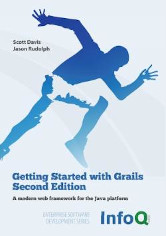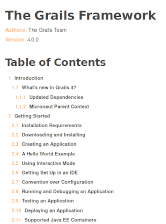Last Updated on May 22, 2022
Apache Groovy is a powerful, optionally typed and dynamic language, with static-typing and static compilation capabilities, for the Java platform aimed at improving developer productivity thanks to a concise, familiar and easy to learn syntax.
It integrates seamlessly with any Java program, and immediately delivers to your application powerful features, including scripting capabilities, Domain-Specific Language authoring, runtime and compile-time meta-programming and functional programming.
It’s both a static and dynamic language with features similar to those of Python, Ruby, Perl, and Smalltalk. It can be used as both a programming language and a scripting language for the Java Platform.
The Grails and Gradle framework are built using the Groovy language. Most of the Groovy books will cover some Grails and Gradle and the same is true for Grails book, they offer some introduction to the Groovy programming language itself.
1. Getting Started with Grails, Second Edition by Scott Davis, Jason Rudolph
 Getting Started with Grails introduces Grails by example. You’ll see how to quickly build a Grails application from scratch and how to customize it to meet various needs.
Getting Started with Grails introduces Grails by example. You’ll see how to quickly build a Grails application from scratch and how to customize it to meet various needs.
You’ll need a basic knowledge of object-oriented programming and MVC web application development. You’ll benefit from a familiarity with Java.
The book doesn’t aim to explicitly teach Groovy, but the book offers extensive use of the language through its examples.
Chapters cover:
- Installing Grails.
- Creating a Gralls application.
- Validation.
- Relationships.
- Databases.
- Controllers.
- Groovy Server Pages.
- Security.
- Plugins, Services, and Deployment.
It’s available in PDF, EPUB, and MOBI formats. You have to sign up for an account. And there’s a printed version available to purchase.
2. The Grails Framework by The Grails Team
 Grails is an open source web application framework that uses the Apache Groovy programming language (which is in turn based on the Java platform).
Grails is an open source web application framework that uses the Apache Groovy programming language (which is in turn based on the Java platform).
It’s intended to be a high-productivity framework by following the “coding by convention” paradigm, providing a stand-alone development environment and hiding much of the configuration detail from the developer.
3. Spock Framework Reference Documentation by Peter Niederwieser, Leonard Brünings, The Spock Framework Team
 Spock is a testing and specification framework for Java and Groovy applications.
Spock is a testing and specification framework for Java and Groovy applications.
What makes it stand out from the crowd is its beautiful and highly expressive specification language. Thanks to its JUnit runner, Spock is compatible with most IDEs, build tools, and continuous integration servers.
4. Gradle Goodness Notebook by Hubert Klein Ikkink
 Learn more about Gradle features with code snippets and short articles. The articles and code will get you started quickly and will give more insight in Gradle.
Learn more about Gradle features with code snippets and short articles. The articles and code will get you started quickly and will give more insight in Gradle.
The Gradle Goodness Notebook contains the blog posts about Gradle previously mentioned on the author’s blog. The posts have been edited slightly so they can be used for the book. The book gives a broad overview of all the great features in the Gradle build tool.
Read the book. It’s free to read online.
5. The Groovy 2 Tutorial by Duncan Dickinson

This book leads the reader through the basics of Groovy. The author hopes the book gives you a basis in understanding the language.
The book doesn’t include the output of most of the code examples. This is to reduce clutter, and to encourage the reader to experiment with the code.
All books in this series:
| Free Programming Books | |
|---|---|
| Ada | ALGOL-like programming language, extended from Pascal and other languages |
| Agda | Dependently typed functional language based on intuitionistic Type Theory |
| Arduino | Inexpensive, flexible, open source microcontroller platform |
| Assembly | As close to writing machine code without writing in pure hexadecimal |
| Awk | Versatile language designed for pattern scanning and processing language |
| Bash | Shell and command language; popular both as a shell and a scripting language |
| BASIC | Beginner’s All-purpose Symbolic Instruction Code |
| C | General-purpose, procedural, portable, high-level language |
| C++ | General-purpose, portable, free-form, multi-paradigm language |
| C# | Combines the power and flexibility of C++ with the simplicity of Visual Basic |
| Clojure | Dialect of the Lisp programming language |
| ClojureScript | Compiler for Clojure that targets JavaScript |
| COBOL | Common Business-Oriented Language |
| CoffeeScript | Transcompiles into JavaScript inspired by Ruby, Python and Haskell |
| Coq | Dependently typed language similar to Agda, Idris, F* and others |
| Crystal | General-purpose, concurrent, multi-paradigm, object-oriented language |
| CSS | CSS (Cascading Style Sheets) specifies a web page’s appearance |
| D | General-purpose systems programming language with a C-like syntax |
| Dart | Client-optimized language for fast apps on multiple platforms |
| Dylan | Multi-paradigm language supporting functional and object-oriented coding |
| ECMAScript | Best known as the language embedded in web browsers |
| Eiffel | Object-oriented language designed by Bertrand Meyer |
| Elixir | Relatively new functional language running on the Erlang virtual machine |
| Erlang | General-purpose, concurrent, declarative, functional language |
| F# | Uses functional, imperative, and object-oriented programming methods |
| Factor | Dynamic stack-based programming language |
| Forth | Imperative stack-based programming language |
| Fortran | The first high-level language, using the first compiler |
| Go | Compiled, statically typed programming language |
| Groovy | Powerful, optionally typed and dynamic language |
| Haskell | Standardized, general-purpose, polymorphically, statically typed language |
| HTML | HyperText Markup Language |
| Icon | Wide variety of features for processing and presenting symbolic data |
| J | Array programming language based primarily on APL |
| Java | General-purpose, concurrent, class-based, object-oriented, high-level language |
| JavaScript | Interpreted, prototype-based, scripting language |
| Julia | High-level, high-performance language for technical computing |
| Kotlin | More modern version of Java |
| LabVIEW | Designed to enable domain experts to build power systems quickly |
| LaTeX | Professional document preparation system and document markup language |
| Lisp | Unique features - excellent to study programming constructs |
| Logo | Dialect of Lisp that features interactivity, modularity, extensibility |
| Lua | Designed as an embeddable scripting language |
| Markdown | Plain text formatting syntax designed to be easy-to-read and easy-to-write |
| Objective-C | Object-oriented language that adds Smalltalk-style messaging to C |
| OCaml | The main implementation of the Caml language |
| Pascal | Imperative and procedural language designed in the late 1960s |
| Perl | High-level, general-purpose, interpreted, scripting, dynamic language |
| PHP | PHP has been at the helm of the web for many years |
| PostScript | Interpreted, stack-based and Turing complete language |
| Prolog | A general purpose, declarative, logic programming language |
| PureScript | Small strongly, statically typed language compiling to JavaScript |
| Python | General-purpose, structured, powerful language |
| QML | Hierarchical declarative language for user interface layout - JSON-like syntax |
| R | De facto standard among statisticians and data analysts |
| Racket | General-purpose, object-oriented, multi-paradigm, functional language |
| Raku | Member of the Perl family of programming languages |
| Ruby | General purpose, scripting, structured, flexible, fully object-oriented language |
| Rust | Ideal for systems, embedded, and other performance critical code |
| Scala | Modern, object-functional, multi-paradigm, Java-based language |
| Scheme | A general-purpose, functional language descended from Lisp and Algol |
| Scratch | Visual programming language designed for 8-16 year-old children |
| SQL | Access and manipulate data held in a relational database management system |
| Standard ML | General-purpose functional language characterized as "Lisp with types" |
| Swift | Powerful and intuitive general-purpose programming language |
| Tcl | Dynamic language based on concepts of Lisp, C, and Unix shells |
| TeX | Markup and programming language - create professional quality typeset text |
| TypeScript | Strict syntactical superset of JavaScript adding optional static typing |
| Vala | Object-oriented language, syntactically similar to C# |
| VHDL | Hardware description language used in electronic design automation |
| VimL | Powerful scripting language of the Vim editor |
| XML | Rules for defining semantic tags describing structure ad meaning |
